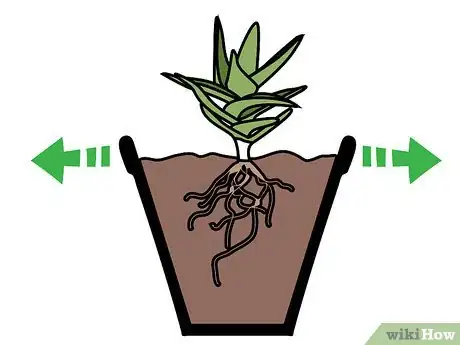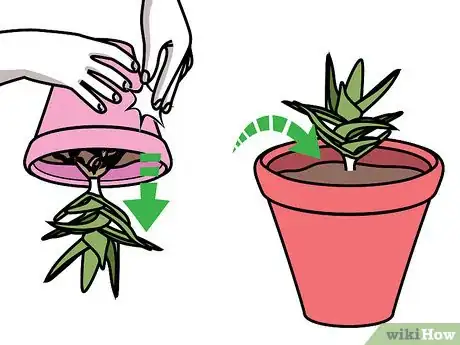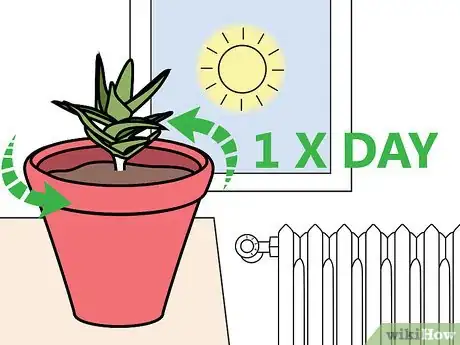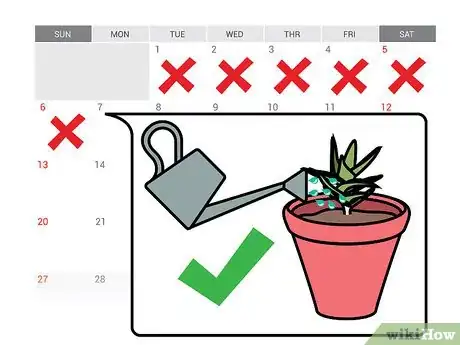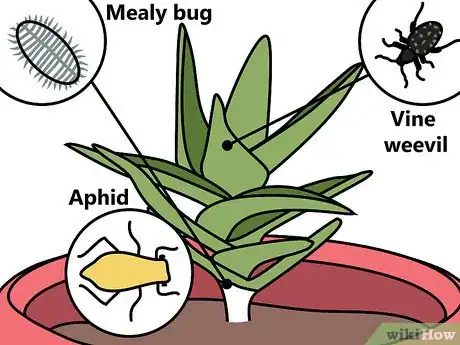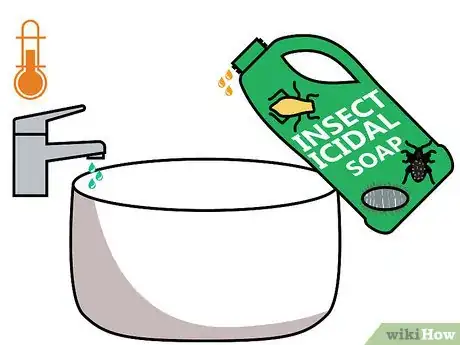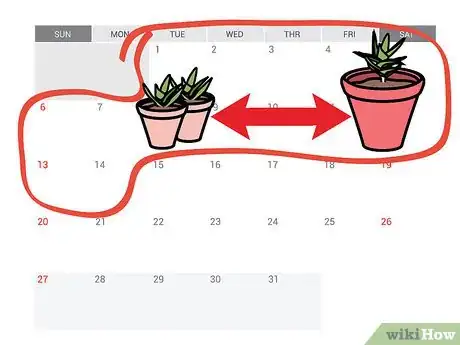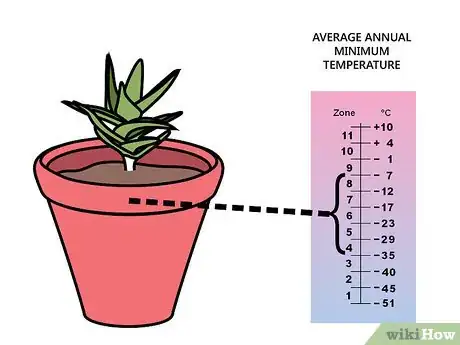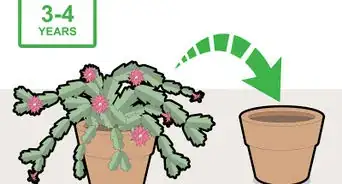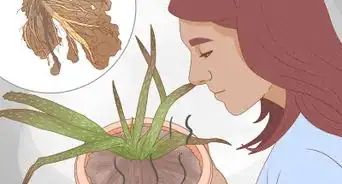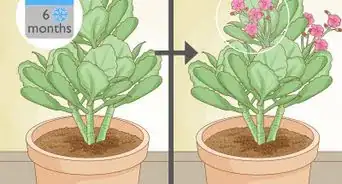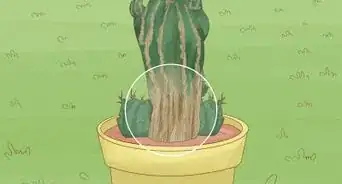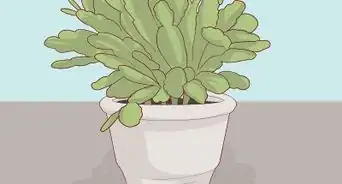This article was co-authored by Lauren Kurtz. Lauren Kurtz is a Naturalist and Horticultural Specialist. Lauren has worked for Aurora, Colorado managing the Water-Wise Garden at Aurora Municipal Center for the Water Conservation Department. She earned a BA in Environmental and Sustainability Studies from Western Michigan University in 2014.
There are 9 references cited in this article, which can be found at the bottom of the page.
wikiHow marks an article as reader-approved once it receives enough positive feedback. In this case, 95% of readers who voted found the article helpful, earning it our reader-approved status.
This article has been viewed 111,156 times.
The word “succulent” refers to any kind of fleshy plant that can grow in dry conditions and in a variety of agricultural zones. On average, they're easy to care for and attract few species of pests. To grow healthy plants, you need to know how to care for them in general and how to deal with the pests that could attack. It's also helpful to know how to choose plants that are appropriate for where you live.
Steps
Caring for Succulents in General
-
1Purchase a sturdy wide pot. This is necessary for all varieties of succulents. They have thick roots that spread out and require a wide diameter for proper growth. If your variety grows large and top-heavy, aim for a sturdy pot that won't tip over. Terra cotta is a good choice.
- Make sure the pot has drainage holes at or near the bottom. If you're repurposing a container, avoid glass or other materials that you can't add holes to.
- Varieties with roots that remain close to the soil surface will thrive in a shallow pot. Those with taproots that penetrate deeply into the soil require a taller pot. Read the care instructions that come with your plant (usually on a plastic tab that sticks in the soil) for details.[1]
-
2Fill the pot with cactus soil mix. Look for cactus soil mix at your local garden center. Read the label to make sure it contains equal parts compost, horticultural sand, and grit. Double check that all ingredients are horticultural-grade.[2]Advertisement
-
3Pot the succulent. Invert the original pot and tap it gently to loosen the plant. Carefully clear the soil away from the roots using a chopstick or toothpick. Then, place the plant in the new pot. Use soil mix to cover the bottom of the plant to the same point that it was covered in the original pot.
- If the succulent outgrows its current pot, repot it. The new pot should be slightly larger than the old one to allow for new growth.[3]
-
4Put the plant in a sunny place. If you live in a hot climate, put your plant in a location that gets 6-8 hours of filtered sunlight each day. In colder climates, 6 hours of full sun is acceptable. For indoor plants, choose a window where the plant can get full sun.
- Don't put your plant in a south-facing window if you live in a hot climate. If you live in a cooler climate, test any south-facing windows for too much heat in the afternoon. The plant can become sunburned with too much sunlight.
- If you have a “-veria” succulent, keep it out of the direct afternoon sun to avoid sunburn.[4]
-
5Water at least weekly during the growing season. The frequency of waterings depends on the variety of the succulent. Make sure the soil is moist at all times during the spring and summer months. Follow the care instructions for details specific to your variety.
- Avoid overwatering, which can cause root rot.[5]
-
6Reduce waterings during the dormant season. Like deciduous trees, succulents enter a dormancy phase during the fall and winter months. Allow the soil to dry completely before rewatering during this time. Depending on the variety, this can be as little as once a month.[6]
- Some flowering varieties need more water than ones that don't produce flowers. Read the care instructions for details.[7]
-
7Bring the succulents inside during freezing weather. You can overwinter the plants inside by putting them in a warm, sunny windowsill. Wait until the last frost has passed before putting them back outside.
Fighting Pests
-
1Identify common pests. Mealy bugs, aphids, and vine weevils are the most common pests that succulents attract. Check for mealy bugs at the point where the leaf attaches to the stem. Look for aphids on leaves, stems, and flower buds. Watch for impaired growth or limpness, which is evidence of vine weevils or root mealy bugs.[8]
- Mealy bugs are usually about 2 millimetres (0.079 in) to 3 millimetres (0.12 in) long and resemble lice. When they first attack, they'll leave balls of white fluff on the plant. When squashed, they leave a red stain.
- Aphids are about 0.25 inches (0.64 cm) long. Their bodies are pear-shaped and can be black, green, yellow, pink, gray, or brown.[9]
- Scale are small gray bugs. They may look like a cluster of small, cottony pinheads.
-
2Fight mealy bugs, scale, and aphids with insecticidal soap. Mix a few drops of soap in tepid water. If you have severe infestation, add a few drops of cooking oil to the mixture. Apply it to the affected areas with a cotton swab or spray bottle. You can buy insecticidal soap at your local nursery.[10]
- For root mealy bugs, remove and discard of the soil. Replant the succulent in fresh, clean soil.[11]
-
3Quarantine new plants. Pests can “hitchhike” on plants fresh from the nursery. If you're already growing succulents, isolate the new arrivals for about two weeks. Check for pests and signs of disease daily.
- After you plant your succulent in its permanent location, continue to monitor for problems at least once a week.[12]
Choosing the Appropriate Succulents for Where You Live
-
1Purchase zone-appropriate varieties. Succulents are available in varieties that can grow in agricultural zones as cold as Zone 4 and as hot as Zone 9. If you live anywhere between Zones 4 and 7, go for the sempervivum or similar variety. For Zones 8 and 9, opt for more heat- and drought-tolerant varieties. Before you make the final purchase, read the label on the plant or speak to an expert at your local nursery.[13]
- If you're not certain which zone you live in, visit the website for the United States Department of Agriculture (USDA) or non-U.S. equivalent for assistance.
-
2Check the drainage of your soil. Succulents need soil with good drainage. Avoid low spots in the garden where water can pool. If your garden soil stays soggy for a long period of time, read up on how to improve the drainage.
-
3Buy native varieties, if possible. You'll have this advantage if you live in a dry climate. Native succulents have their own built-in defenses against pests in your area. They also invite local beneficial insects that could help in the growth and propagation of other plant varieties in your garden. Visit your state or provincial government website, university websites, or local botanical societies for assistance.
Expert Q&A
-
QuestionCan you keep California Sunset succulents indoors? What kind of pests are common?
 Lauren KurtzLauren Kurtz is a Naturalist and Horticultural Specialist. Lauren has worked for Aurora, Colorado managing the Water-Wise Garden at Aurora Municipal Center for the Water Conservation Department. She earned a BA in Environmental and Sustainability Studies from Western Michigan University in 2014.
Lauren KurtzLauren Kurtz is a Naturalist and Horticultural Specialist. Lauren has worked for Aurora, Colorado managing the Water-Wise Garden at Aurora Municipal Center for the Water Conservation Department. She earned a BA in Environmental and Sustainability Studies from Western Michigan University in 2014.
Professional Gardener This succulent can be kept indoors if there is adequate sunlight. Overwinter this plant indoors or in a frost free area if you live in a cold region. This succulent is susceptible to the same pests as other succulents such as, aphids, mealy bugs
This succulent can be kept indoors if there is adequate sunlight. Overwinter this plant indoors or in a frost free area if you live in a cold region. This succulent is susceptible to the same pests as other succulents such as, aphids, mealy bugs -
QuestionHow do I know what pests are bad for my succulent?
 Lauren KurtzLauren Kurtz is a Naturalist and Horticultural Specialist. Lauren has worked for Aurora, Colorado managing the Water-Wise Garden at Aurora Municipal Center for the Water Conservation Department. She earned a BA in Environmental and Sustainability Studies from Western Michigan University in 2014.
Lauren KurtzLauren Kurtz is a Naturalist and Horticultural Specialist. Lauren has worked for Aurora, Colorado managing the Water-Wise Garden at Aurora Municipal Center for the Water Conservation Department. She earned a BA in Environmental and Sustainability Studies from Western Michigan University in 2014.
Professional Gardener Any pest that is damaging your plant is bad for it. Identify the pest and treat the infestation accordingly. Not all insects are pests. Be sure your plant is being damaged before taking extreme control measures.
Any pest that is damaging your plant is bad for it. Identify the pest and treat the infestation accordingly. Not all insects are pests. Be sure your plant is being damaged before taking extreme control measures. -
QuestionI have a Zebra Hawarthia. I live in Mumbai, presently the climate here is around 35 Celsius with good humidity. Leaves of my succulent have started to weaken and are dropping, what can I do?
 Eagle7777777Community AnswerIt either needs more light, or you're overwatering it.
Eagle7777777Community AnswerIt either needs more light, or you're overwatering it.
Things You'll Need
- Wide flower pot(s)
- Cactus soil mix
- Insecticidal soap
- Cotton swabs
Warnings
- Avoid fertilizer. It can actually hurt some succulents.⧼thumbs_response⧽
References
- ↑ http://www.csssj.org/welcome_visitors/basic_culture.html
- ↑ http://www.csssj.org/welcome_visitors/basic_culture.html
- ↑ http://www.csssj.org/welcome_visitors/basic_culture.html
- ↑ https://www.succulentsandsunshine.com/guide-growing-succulents-indoor-house-plants/
- ↑ http://www.csssj.org/welcome_visitors/basic_culture.html
- ↑ http://www.csssj.org/welcome_visitors/basic_culture.html
- ↑ https://www.rhs.org.uk/advice/profile?PID=849
- ↑ https://www.rhs.org.uk/advice/profile?pid=849
- ↑ http://www.almanac.com/pest/aphids
- ↑ http://www.nytimes.com/1981/01/15/garden/soap-and-vinegar-are-fine-insecticides.html
- ↑ http://ipm.ucanr.edu/PMG/r280301011.html
- ↑ http://www.missouribotanicalgarden.org/gardens-gardening/your-garden/help-for-the-home-gardener/advice-tips-resources/pests-and-problems/insects/mealybugs/insect-pests-of-cacti-and-succulents.aspx
- ↑ http://www.gardeners.com/how-to/growing-succulents-in-containers/7020.html
About This Article
To take care of your succulent, make sure you plant it in a wide pot because succulent roots spread out. Use cactus soil for planting, then place your succulent in a sunny place and water it at least once per week during the growing season. When it gets cold, water succulents less often and try taking them inside if it freezes. To deal with pests like mealy bugs, aphids, and scale, mix a few drops of insecticidal soap with water and apply it to the affected areas with a cotton swab. To learn more from our Horticulturist co-author, like which succulents will grow well in your area, keep reading the article!
